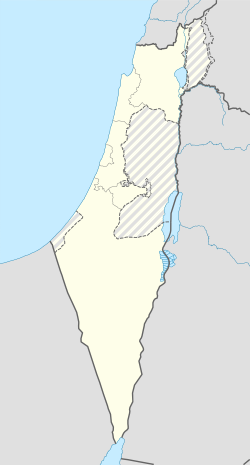
Umm al-Fahm is a city located 20 kilometres northwest of Jenin in the Haifa District of Israel. In 2022 its population was 58,665, nearly all of whom are Arab citizens of Israel. The city is situated on the Umm al-Fahm mountain ridge, the highest point of which is Mount Iskander, overlooking Wadi Ara. Umm al-Fahm is the social, cultural and economic center for residents of the Wadi Ara and Triangle regions.
'Ara is a village in the Haifa District in northern Israel, located in the Wadi Ara valley. Since 1985, 'Ara has been part of the Ar'ara local council. It is located north of highway 65, between Ar'ara and Kfar Qara. Its population of 4,600 is almost entirely Muslim.
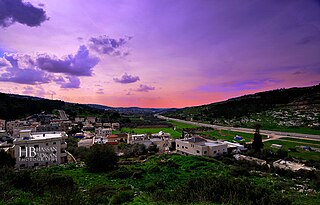
Wadi Ara or Nahal 'Iron, is a valley and its surrounding area in Israel populated mainly by Arab Israelis. The area is also known as the "Northern Triangle".

Barta'a is an Arab village located in the northern triangle area and Nahal Iron, which is split by the Green Line separating Israel from the West Bank. This division resulted in the separation of the village into two parts: one located within the State of Israel and the other in the West Bank. Historically, the residents of Barta'a faced challenges related to this bifurcation, impacting their social and economic interactions. In recent years, efforts have been made to reunify the village, facilitating the integration of its eastern and western sections.
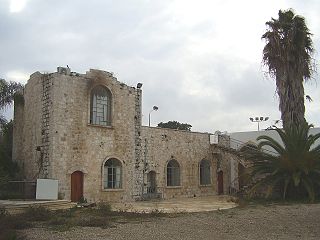
Wadi Ara was a Palestinian village located 38.5 km south of the city of Haifa. It is named after the nearby stream that is known in Arabic as Wadi 'Ara. The village was particularly small with a population of 230 and a land area of approximately 9,800 dunums.

Basma is an Israeli Arab local council in the Wadi Ara area of Haifa District. The local council was formed in 1995 through the consolidation of the villages of Barta'a West, Ein as-Sahala, and Muawiya; Basma is an acronym of the villages' names. In 2022 it had a population of 10,743. Basma's jurisdiction area covers 3,956 dunams.
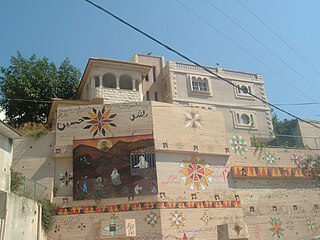
Ma'ale Iron is an Arab local council in Israel's Haifa District and is a part of the Wadi Ara region in the Triangle. The town consists of the five villages of Bayada, Musheirifa, Musmus, Salem and Zalafa. The villages were joined together in 1996 by the Interior Ministry of Israel to form the local council. In 2022 its population was 15,861, predominantly Muslims. It has an area of 6.3 km2. Ma'ale Iron has four elected members and since 2013 the head of the council has been Mustafa Ighbarieh.
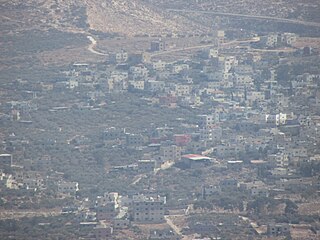
Salim is a Palestinian town in the northern West Bank, located six kilometers east of Nablus and is a part of the Nablus Governorate. According to the Palestinian Central Bureau of Statistics (PCBS), Salim had a population of 6,266 inhabitants in 2017.

Silat al-Harithiya is a Palestinian village in the Jenin Governorate of Palestine, located 10 kilometres (6.2 mi) northwest of Jenin in the northern West Bank. According to the Palestinian Central Bureau of Statistics census, the town had a population of 9,422 in 2007 and 11,449 in 2017.

Lajjun was a large Palestinian Arab village located 16 kilometers (9.9 mi) northwest of Jenin and 1 kilometer (0.62 mi) south of the remains of the biblical city of Megiddo. The Israeli kibbutz of Megiddo, Israel was built 600 metres north-east of the depopulated village on the hill called Dhahrat ed Dar from 1949.
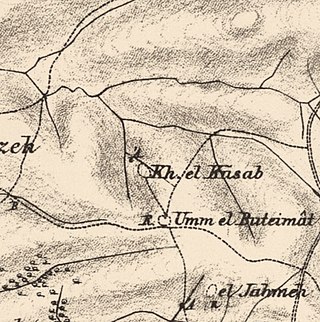
Al-Butaymat was a Palestinian Arab village the Haifa Subdistrict, located 31 kilometers (19 mi) southeast of Haifa. It was depopulated during the 1947–48 Civil War in Mandatory Palestine on May 1, 1948, under the Battle of Mishmar HaEmek.
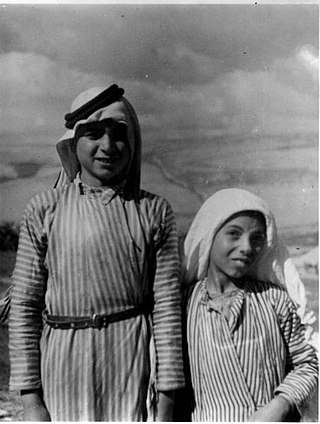
Al-Kafrayn was a Palestinian village in the Haifa Subdistrict. It was depopulated during the 1947–48 Civil War in Mandatory Palestine on 12 April 1948 as part of the Battle of Mishmar HaEmek. It was located 29.5 km southeast of Haifa.

Ayn al-Mansi was a Palestinian Arab village in the District of Jenin of the Mandatory Palestine. It was depopulated as a result of a military attack in mid-April during the 1947–48 Civil War in Mandatory Palestine.

Musmus is an Arab village in Haifa District. The village is located in the Wadi Ara area of the northern Triangle, 4 kilometres (2.5 mi) northeast of Umm al-Fahm. Since 1996, it has been under the jurisdiction of the Ma'ale Iron local council. The village is divided into five neighborhoods: Abu Shehab, Ighbarieh, Southeast, Mahagna, and Sharqawi. In mid-2016, Musmus' population was 4,215, all of whom were Muslim.
Most of the villagers belong to the Ighbarieh and Mahagna clans. The village is the birthplace of the Palestinian poet Rashid Hussein. Highway 65 passes through the village and splits it into two parts.

Al-Musheirifa is an Arab village in Israel's Haifa District. The village is located in the Wadi Ara area of the northern Triangle, 4 kilometres (2.5 mi) northeast of Umm al-Fahm. Since 1996, it has been under the jurisdiction of the Ma'ale Iron local council. In mid-2016 Musheirifa's population was 3472, all of whom are Muslim. The village is divided into four neighborhoods: Ighbarieh, El-Manshya, Jabbarin, and the Old Village. The inhabitants are largely members of the Ighbarieh clan, which inhabits the upper parts of the village, and the Jabbarin clan, which inhabit the lower parts. Bayada was a neighborhood of the village in the past but split from it and became a new village. The village has poor infrastructure and, like many other villages in the Wadi Ara region, lacks many social institutions and recreational areas.
Ein as-Sahla is an Arab village in Haifa District, Israel. The village is located in the Wadi Ara area of the northern Triangle. The village has about 2,000 residents. Since 1996, it has been under the jurisdiction of the Basma local council. The vast majority of the residents in Ein as-Sahla adhere to Islam.
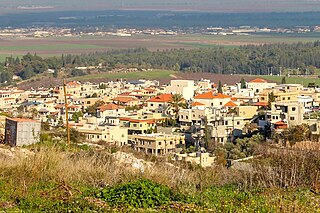
Salem or Salim is an Arab village in Israel's Haifa District. The village is in the Wadi Ara area of the northern Triangle, 4 kilometers northeast of Umm al-Fahm. Since 1996, it has been under the jurisdiction of the Ma'ale Iron local council. In mid-2016 Salem's population was 1,699, predominantly Muslims. The village is divided into five neighborhoods: Abu Bakr, Darwish, Subaihat, Ayash and Rifai. Most of the adult males in the village work in manual labour.
Bayada or Khirbet al-Baiyada is an Arab village in Israel's Haifa District. The village is in the Wadi Ara area of the northern Triangle, 4 kilometers northeast of Umm al-Fahm. Since 1996, it has been under the jurisdiction of the Ma'ale Iron local council. In mid-2016 the population of Bayada was 486, all of whom are Muslims.

Mu'awiya is an Arab village in Israel's Haifa District. The village is in the Wadi Ara area of the northern Triangle and lies between Kfar Kara and Umm el-Fahm. The village has around 3,100 residents. Since 1996, it has been under the jurisdiction of the Basma local council. The village is divided into two neighborhoods: eastern and western. The residents of the village belong to two clans: Ighbarieh and Mahmid.

Jo'ara is a former military installation in the Menashe Heights. A small Palestinian Arab village existed on the hill until the 1930s. Between 1938 and 1948, it became the main military school for commanding officers of the Haganah and Palmach. After the establishment of Israel, the hill was used as a military base and officers school, and between 1970 and 2016 by the Youth Battalions' (Gad'na) pre-military programme. The base and its museum were closed down in 2016–2017.

